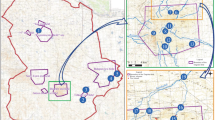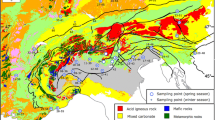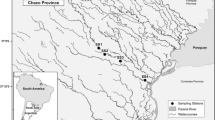Abstract
Large rivers are a major pathway for the erosion products of continents to reach the oceans. The riverine transport of dissolved and particulate materials is generally related to a large number of interactions involving climate, hydrological, physico-chemical and biological aspects. Consequently, the investigation of large rivers allows the erosion processes at a global scale to be addressed, with information about biogeochemical cycles of the elements, weathering rates, physical erosion rates and CO2 consumption by the acid degradation of continental rocks. Today, good databases exist for the major dissolved ions in the world’s largest rivers. Since concentration of ions in river waters has to be considered in a compositional context, it is necessary to study the implications of considering the simplex, with its proper geometry, as the natural sample space. Using the additive (alr) or the isometric (ilr) log-ratio transformations, a composition can be represented as a real vector; but only in the second case can these coordinates be mapped onto orthogonal axes.
Using data related to the dissolved load of some of the most important rivers in the world, the relationships among the major ions frequently used in molar ratio mixing diagrams have been investigated with alternative tools. Following the balances approach, an investigation of the properties of aqueous solutions of electrolytes that are often treated in terms of equilibrium constants is undertaken. The role played by the source—rain water, weathering of silic, carbonatic and evaporitic rocks, pollution—from which elements and chemical species can potentially be derived, has been checked through an investigation of a probabilistic model able to describe the relationships among the different components that contribute to the chemical composition of a river water sample.
Similar content being viewed by others
References
Aitchison J (1986) The statistical analysis of compositional data. Monographs on statistics and applied probability. Chapman & Hall, London, 416 p. (Reprinted in 2003 with additional material by The Blackburn Press)
Anderson SP, Lougacre SA, Kraal ER (2003) Patterns of water chemistry and discharge in the glacier-fed Kennicott River, Alaska: evidence for subglacial water storage cycles. Chem Geol 202:297–312
Berner EK, Berner RA (1996) Global environment: water, air, and geochemical cycles. Prentice Hall, Englewood Cliffs, 376 p
Bickle MJ, Chapman HJ, Bunbury J, Harris NB, Fairchild IJ, Ahmad T, Pomiès C (2005) Relative contributions of silicate and carbonate rocks to riverine Sr fluxes in the headwaters of the Ganges. Geochim Cosmochim Acta 69(9):2221–2240
Bowman AW, Azzalini A (1997) Applied smoothing techniques for data analysis: The kernel approach with S-Plus illustrations. Clarendon, Oxford, 193 p
Chadwick OA, Gavenda RT, Kelly EF, Ziegler K, Olson CG, Elliott WC, Hendricks DM (2003) The impact of climate on the biogeochemical functioning of volcanic soils. Chem Geol 202:195–223
Dessert C, Dupré B, François LM, Schott J, Gaillardet J, Chakrapani G, Bajpai S (2001) Erosion of Deccan Traps determined by river geochemistry: impact on the global climate and the 87Sr/86Sr ratio of seawater. Earth Planet Sci Lett 188:459–474
Douglas TA (2006) Seasonality of bedrock weathering chemistry and CO2 consumption in a small watershed, the White River, Vermont. Chem Geol 231:236–251
Edmond JM, Palmer MR, Measures CI, Grant B, Stallard RF (1995) The fluvial geochemistry and denudation rate of the Guayana Shield in Venezuela, Colombia, and Brazil. Geochim Cosmochim Acta 59(16):3301–3325
Egozcue JJ, Pawlowsky-Glahn V (2005) Groups of parts and their balances in compositional data analysis. Math Geol 37(7):795–828
Egozcue JJ, Pawlowsky-Glahn V (2006) Simplicial geometry for compositional data. Special publications, vol 264. Geological Society, London
Egozcue JJ, Pawlowsky-Glahn V, Mateu-Figueras G, Barceló-Vidal C (2003) Isometric logratio transformations for compositional data analysis. Math Geol 35(3):279–300
Favara R, Grassa F, Valenza M (2000) Hydrochemical evolution and environmental features of Salso River catchment, central Sicily, Italy. Environ Geol 39(11):1205–1215
Gaillardet J, Dupré B, Allègre CJ, Négrel P (1997) Chemical and physical denudation in the Amazon River Basin. Chem Geol 142:141–173
Gaillardet J, Dupré B, Louvat P, Allègre CJ (1999) Global silicate weathering and CO2 consumption rates deduced from the chemistry of large rivers. Chem Geol 159:3–30
Galy A, France-Lanord C (1999) Weathering processes in the Gange–Brahmaputra basin and the riverine alkalinity budget. Chem Geol 159:31–60
Garrels RM, MacKenzie FT (1971) Evolution of sedimentary rocks. Norton, New York, 397 p
Meybeck M (1979) Concentrations des eaux fluviales en èlèments majeurs et apports en solution aux ocèans. Rev Geol Dyn Geogr Phys 21(3):215–246
Meybeck M (1983) Atmospheric inputs and river transport of dissolved substances. In: Proceedings of the Hamburg symposium, August 1983, vol 141. IAHS, Wallingford
Meybeck M (1986) Composition chimique des ruisseaux non pollués de France. Sci Geol Bull 39(1):3–77
Meybeck M (1987) Global chemical weathering from surficial rocks estimated from river dissolved loads. Am J Sci 287:401–428
Millot R, Gaillardet J, Dupré B, Allègre CJ (2002) The global control of silicate weathering rates and the coupling with physical erosion: new insights from rivers of the Canadian Shield. Earth Planet Sci Lett 196:83–89
Millot R, Gaillardet J, Dupré B, Allègre CJ (2003) Northern latitude chemical weathering rates: clues from the Mackenzie River Basin, Canada. Geochim Cosmochim Acta 67(7):1305–1329
Mortatti J, Probst JL (2003) Silicate rock weathering and atmospheric/soil CO2 uptake in the Amazon basin estimated from river water geochemistry: seasonal and spatial variations. Chem Geol 197:177–196
Négrel P, Allègre CJ, Dupré B, Lewin E (1993) Erosion sources determined by inversion of major and trace element ratios in river water: the Congo Basin case. Earth Planet Sci Lett 120:59–76
Oliva P, Viers J, Dupré B (2003) Chemical weathering in granitic crystalline environments. Chem Geol 202:225–256
Qin J, Huh Y, Edmond JM, Du G, Ran J (2006) Chemical and physical weathering in the Min Jiang, a headwater tributary of the Yangtze River. Chem Geol 227:53–69
Quade J, English N, DeCelles P (2003) Silicate versus carbonate weathering in the Himalaya: a comparison of the Arun and Seti River watersheds. Chem Geol 202:275–296
Roy S, Gaillardet J, Allègre CJ (1999) Geochemistry of dissolved and suspended loads of the Seine river, France: anthropogenic impact, carbonate and silicate weathering. Geochim Cosmochim Acta 63(9):1277–1292
Spence J, Telmer K (2005) The role of sulfur in chemical weathering and atmospheric CO2 fluxes: evidence from major ions, δ 13 C DIC, and \(\delta^{34}{S}_{\mathrm{SO}_{4}}\) in rivers of the Canadian Cordillera. Geochim Cosmochim Acta 69(23):5441–5458
Stallard RF (1980) Major element chemistry of the Amazon River System. PhD thesis, MIT/WHOI
Stallard RF, Edmond JM (1987) Geochemistry of the Amazon, 3. Weathering chemistry and limits to dissolved inputs. J Geophys Res 92:8293–8302
Tipper ET, Bickle MJ, Galy A, West AJ, Pomiès C, Chapman HJ (2006) The short term climatic sensitivity of carbonate and silicate weathering fluxes: insight from seasonal variations in river chemistry. Geochim Cosmochim Acta 40(11):2737–2754
Viers J, Dupré B, Polvé M, Schott J, Dandurand JL, Braun JJ (1997) Chemical weathering in the drainage basin of a tropical watershed (Nsimi-Zoetele site, Cameroon): comparison between organic poor and organic rich waters. Chem Geol 140:181–206
Viers J, Dupré B, Braun JJ, Deberdt S, Angeletti B, Ngoupayou JN, Michard A (2000) Major and trace element abundances, and strontium isotopes in the Nyong basin rivers (Cameroon: constraints on chemical weathering processes and elements transport mechanisms in humid tropical environments). Chem Geol 169:211–241
Author information
Authors and Affiliations
Corresponding author
Rights and permissions
About this article
Cite this article
Buccianti, A., Egozcue, J.J. & Pawlowsky-Glahn, V. Another Look at the Chemical Relationships in the Dissolved Phase of Complex River Systems. Math Geosci 40, 475–488 (2008). https://doi.org/10.1007/s11004-008-9168-2
Received:
Accepted:
Published:
Issue Date:
DOI: https://doi.org/10.1007/s11004-008-9168-2




